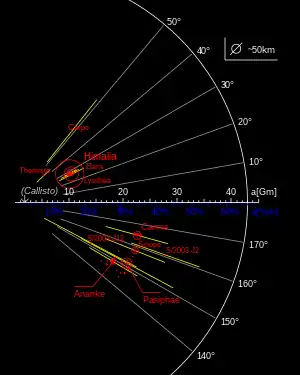

The Himalia group is a group of prograde irregular satellites of Jupiter that follow similar orbits to Himalia and are thought to have a common origin.[1]
The known members of the group are (in order of increasing distance from Jupiter):
| Name | Diameter (km) | Period (days) | Notes |
|---|---|---|---|
| Leda | 21.5 | 240.93 | |
| Ersa | 3 | 249.23 | |
| Himalia | 139.6 (150 × 120) | 250.56 | largest member and group prototype |
| S/2018 J 2 | 3 | 250.88 | |
| Pandia | 3 | 251.91 | |
| Lysithea | 42.2 | 259.20 | |
| Elara | 79.9 | 259.64 | |
| S/2011 J 3 | 3 | 261.77 | |
| Dia | 4 | 278.21 |
Two additional possible satellites discovered by Sheppard in 2017 have been identified to be likely part of the Himalia group, but were too faint (mag >24) to be tracked and confirmed as satellites.[2]
The International Astronomical Union (IAU) reserves names for moons of Jupiter ending in -a (Leda, Himalia and so on) for the moons in this group to indicate prograde motions of these bodies relative to Jupiter, their gravitationally central object.[3]
Characteristics and origin
The objects in the Himalia group have semi-major axes (distances from Jupiter) in the range of 11.10 and 12.30 Gm, inclinations between 27.2° and 29.1°, and eccentricities between 0.11 and 0.24. All orbit in a prograde direction. In physical appearance, the group is very homogeneous, all satellites displaying neutral colours (colour indices B−V = 0.66 and V−R = 0.36) similar to those of C-type asteroids. Given the limited dispersion of the orbital parameters and the spectral homogeneity, it has been suggested that the group could be a remnant of the break-up of an asteroid from the main asteroid belt.[4] The radius of the parent asteroid was probably about 89 km, only slightly larger than that of Himalia, which retains approximately 87% of the mass of the original body. This indicates the asteroid was not heavily disturbed.[1]
Numerical integrations show a high probability of collisions among the members of the prograde group during the lifespan of the solar system (e.g. on average 1.5 collisions between Himalia and Elara). In addition, the same simulations have shown fairly high probabilities of collisions between prograde and retrograde satellites (e.g. Pasiphae and Himalia have a 27% probability of collision within 4.5 gigayears). Consequently, it has been suggested that the current group could be a result of a more recent, rich collisional history among the prograde and retrograde satellites as opposed to the single break-up shortly after the planet formation that has been inferred for the Carme and Ananke groups.[5]
References
- 1 2 Scott S. Sheppard, David C. Jewitt An abundant population of small irregular satellites around Jupiter, Nature, 423 (May 2003), pp.261-263 (pdf) Archived 2006-08-13 at the Wayback Machine
- ↑ Sheppard, Scott; Williams, Gareth; Tholen, David; Trujillo, Chadwick; Brozovic, Marina; Thirouin, Audrey; et al. (August 2018). "New Jupiter Satellites and Moon-Moon Collisions". Research Notes of the American Astronomical Society. 2 (3): 155. arXiv:1809.00700. Bibcode:2018RNAAS...2..155S. doi:10.3847/2515-5172/aadd15. S2CID 55052745. 155.
- ↑ Antonietta Barucci, M. (2008). "Irregular Satellites of the Giant Planets" (PDF). In M. Antonietta Barucci; Hermann Boehnhardt; Dale P. Cruikshank; Alessandro Morbidelli (eds.). The Solar System Beyond Neptune. University of Arizona Press. p. 414. ISBN 9780816527557. Archived from the original (PDF) on 10 August 2017. Retrieved 22 July 2017.
- ↑ Grav, Tommy; Holman, Matthew J.; Gladman, Brett; Aksnes, Kaare (2003-01-02). "Photometric Survey of the Irregular Satellites". Icarus. 166: 33–45. Retrieved 2024-01-09 – via ArXiv.
- ↑ David Nesvorný, Cristian Beaugé, and Luke Dones Collisional Origin of Families of Irregular Satellites, The Astronomical Journal, 127 (2004), pp. 1768–1783 (pdf).